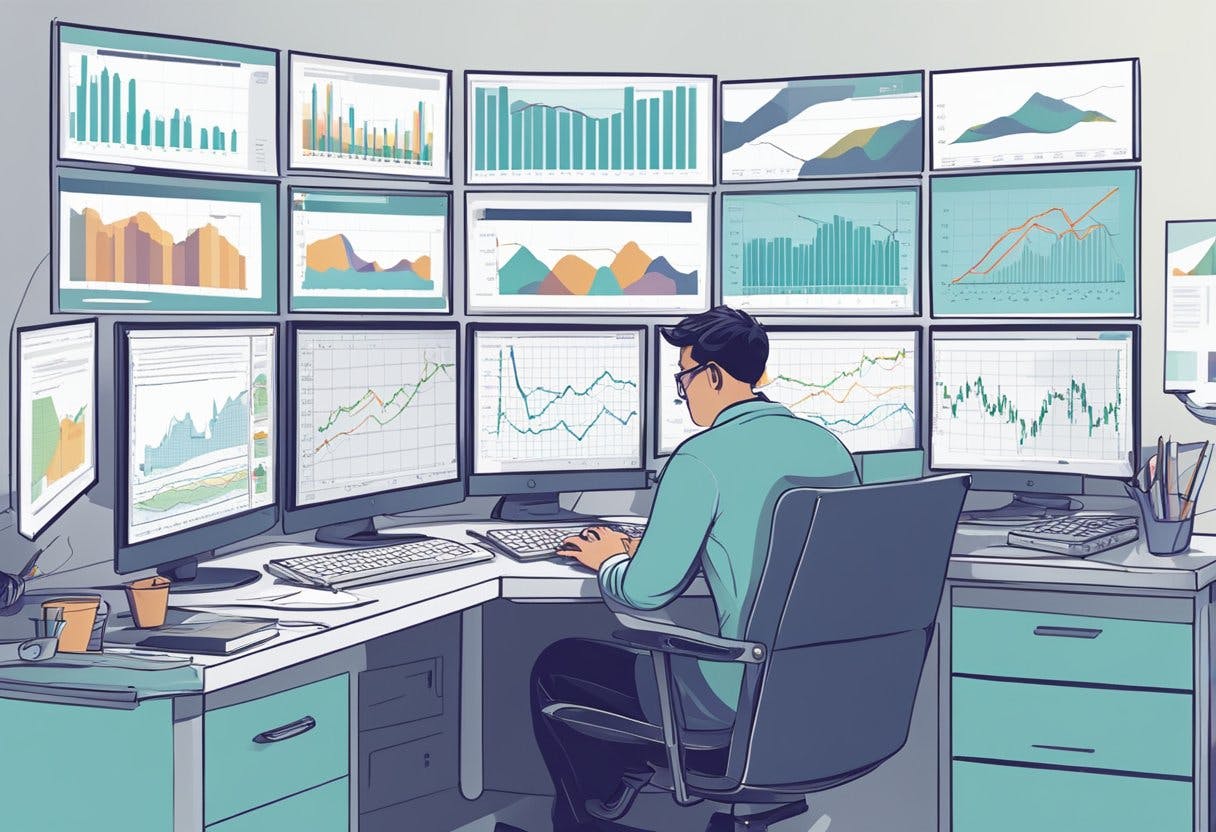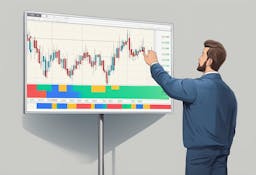
Choosing the right leverage level for trading can be a daunting task for many traders. The leverage level you choose can make or break your trading account. If you choose too high of a leverage level, you risk losing all your capital in a single trade. On the other hand, if you choose too low of a leverage level, you may miss out on potential profits. In this article, we will discuss how to choose the right leverage level for your trading style and risk tolerance.

Understanding leverage in trading is the first step towards choosing the right leverage level. Leverage is a tool that allows traders to control large positions with a small amount of capital. For example, a leverage of 1:100 means that for every dollar you have in your trading account, you can control $100 worth of currency. While leverage can amplify profits, it can also amplify losses. Therefore, it’s important to choose a leverage level that aligns with your risk tolerance and trading style.
Assessing your risk tolerance is an important step in choosing the right leverage level. Risk tolerance refers to the level of risk you are willing to take on in your trading. If you are a conservative trader, you may prefer to use lower leverage levels to minimize the risk of significant losses. On the other hand, if you are an aggressive trader, you may prefer to use higher leverage levels to maximize your profits. It’s important to align your leverage choice with your risk appetite and trading style to ensure a successful trading experience.
Key Takeaways
- Understanding leverage in trading is crucial for choosing the right leverage level.
- Assessing your risk tolerance is important to align your leverage choice with your trading style.
- Risk management strategies and choosing a broker and trading platform are also important factors to consider when choosing the right leverage level.
Understanding Leverage in Trading

The Basics of Leverage
Leverage is a powerful tool for traders to amplify their potential profits. It allows traders to control a large amount of assets with a relatively small amount of capital. In essence, leverage is the use of borrowed funds to increase the potential return on investment.
Forex trading is one of the most popular markets where leverage is used extensively. In forex trading, traders can control large positions with a small amount of margin. Margin is the amount of money required to open and maintain a leveraged position.
Leverage Ratios and Their Meaning
Leverage is often expressed as a ratio, such as 1:10 or 1:100. The first number in the ratio represents the amount of capital that a trader must put up to open a position, while the second number represents the amount of borrowed funds that the trader can control.
High leverage ratios, such as 1:500, can increase potential profits but also increase potential losses. Traders who use high leverage ratios must be prepared to withstand significant market fluctuations. Low leverage ratios, such as 1:10, offer less risk but also less potential reward. Traders who use low leverage ratios may miss out on potential profits but also face less risk of significant losses.
In summary, choosing the right leverage level for a trading style and risk tolerance is crucial. Traders must balance the potential rewards with the potential risks of using leverage. It is important to understand the basics of leverage and leverage ratios before deciding on a leverage level for trading.
Assessing Your Risk Tolerance

Assessing your risk tolerance is an important step in determining the right leverage level for your trading style. Risk tolerance is the level of risk an individual is willing to take when making investment decisions. It is influenced by several factors, including financial situation, age, investment goals, and risk appetite.
Defining Risk Tolerance
Risk tolerance is a personal decision and can vary greatly from person to person. Some individuals may be comfortable with high-risk investments, while others may prefer low-risk investments. It is important to understand that risk tolerance is not the same as risk. Risk is the possibility of losing money, while risk tolerance is the level of risk an individual is willing to take.
Risk Tolerance and Trading Capital
Trading capital is the amount of money an individual has available to invest in the market. It is important to consider trading capital when assessing risk tolerance. A person with a larger trading capital may be able to tolerate more risk than a person with a smaller trading capital.
When determining the right leverage level for your trading style, it is important to consider your risk tolerance and trading capital. A high-risk investment strategy may be appropriate for individuals with a high risk tolerance and a large trading capital. However, individuals with a low risk tolerance and a small trading capital may be better suited for a low-risk investment strategy.
In conclusion, assessing your risk tolerance is an important step in determining the right leverage level for your trading style. It is important to consider your financial situation, age, investment goals, and risk appetite when determining your risk tolerance. Additionally, trading capital should be considered when determining the appropriate level of risk for your investment strategy.
Aligning Leverage with Trading Style
Different Trading Styles
Different trading styles require different levels of leverage. A trader’s trading style depends on their personality, risk tolerance, and time horizon. There are several trading styles, including scalping, swing trading, and position trading.
Scalping is a trading style that involves making multiple trades in a short period to profit from small price movements. Scalpers typically use high leverage to maximize their returns. Swing trading, on the other hand, involves holding positions for several days to capture medium-term price movements. Swing traders generally use lower leverage and focus on capital preservation. Position trading is a long-term trading style that involves holding positions for weeks or months. Position traders use the lowest leverage and prioritize capital preservation over returns.
Matching Leverage to Your Style
To choose the right leverage level, a trader must match it to their trading style. If a trader has a scalping strategy, they should use higher leverage to maximize their returns. If a trader has a swing trading strategy, they should use lower leverage to ensure capital preservation. If a trader has a position trading strategy, they should use the lowest leverage to prioritize capital preservation over returns.
Success in trading depends on several factors, including strategy, risk management, and discipline. Using the right leverage level is essential for a trader’s success. A trader must choose the leverage level that aligns with their trading style and risk tolerance. They must also implement proper risk management techniques to protect their capital and minimize potential losses.
Risk Management Strategies
When trading with leverage, it is crucial to have a risk management strategy in place to protect your downside and manage potential losses. Here are some of the most effective risk management strategies to consider:
Utilizing Stop-Loss Orders
One of the most popular risk management strategies is to use stop-loss orders. These orders automatically close out a trade when the price reaches a predetermined level, helping to protect against further losses. Stop-loss orders can be set at a specific price level or as a percentage of the trade’s value.
Traders should carefully consider where to place their stop-loss orders, as setting them too close to the current price can result in premature exits, while setting them too far away can increase the potential losses. It is important to strike a balance between protecting against losses and allowing for market fluctuations.
The Role of Diversification
Another important risk management strategy is diversification. Diversifying your portfolio by trading multiple instruments can help to spread the risk and reduce the impact of any single trade. This can be achieved by trading different assets or by using different trading strategies.
Traders should also consider the correlation between the instruments they are trading. Correlated assets tend to move in the same direction, so diversifying with uncorrelated assets can provide better protection against market volatility.
In addition to diversification, traders can also use trailing stops to manage risk. Trailing stops automatically adjust the stop-loss level as the trade moves in the trader’s favor, allowing them to lock in profits while still protecting against potential losses.
Overall, managing risk is an essential part of successful leverage trading. By utilizing stop-loss orders, diversifying their portfolio, and using trailing stops, traders can protect their downside and maximize their potential for profits.
Choosing a Broker and Trading Platform
When choosing a broker and trading platform, it is important to consider both the broker’s leverage offerings and the platform’s margin requirements.
Broker’s Leverage Offerings
Different brokers offer different leverage levels, which can range from 1:1 to 1:500 or higher. It is important to choose a broker that offers leverage levels that are suitable for your trading style and risk tolerance.
Traders who prefer higher leverage levels may want to consider brokers that offer leverage levels of 1:100 or higher. However, it is important to keep in mind that higher leverage levels also come with higher risk. Traders with a lower risk tolerance may prefer brokers that offer lower leverage levels, such as 1:30 or 1:50.
It is also important to consider the fees associated with a broker’s leverage offerings. Some brokers may charge higher fees for higher leverage levels, while others may offer lower fees for lower leverage levels.
Platform’s Margin Requirements
In addition to the broker’s leverage offerings, it is important to consider the platform’s margin requirements. Margin is the amount of money that a trader must deposit in order to open and maintain a position.
Different platforms may have different margin requirements, which can range from 1% to 5% or higher. Traders with a smaller account balance may prefer platforms with lower margin requirements, as this allows them to open and maintain positions with a smaller amount of capital.
It is also important to consider the fees associated with a platform’s margin requirements. Some platforms may charge higher fees for higher margin requirements, while others may offer lower fees for lower margin requirements.
Overall, when choosing a broker and trading platform, it is important to consider both the broker’s leverage offerings and the platform’s margin requirements in order to find the best fit for your trading style and risk tolerance.
Frequently Asked Questions
What factors should I consider when selecting leverage for a small trading account?
When selecting leverage for a small trading account, traders should consider their risk tolerance, trading style, and market conditions. It is important to keep in mind that higher leverage increases the potential for both gains and losses. Therefore, traders should choose a leverage level that matches their risk tolerance and trading style.
How does starting capital influence the choice of leverage in forex trading?
Starting capital is an important factor to consider when choosing leverage in forex trading. Traders with smaller accounts may need to use higher leverage to make their trades worthwhile, while traders with larger accounts may be able to use lower leverage. However, it is important to remember that higher leverage also increases risk, so traders should choose a leverage level that matches their risk tolerance and trading style.
What are the key principles a beginner should understand about leverage in trading?
Beginners should understand that leverage is a tool used to amplify gains and losses in trading. Higher leverage increases the potential for both gains and losses, and traders should choose a leverage level that matches their risk tolerance and trading style. It is important to always use proper risk management techniques when trading with leverage.
How do I determine the appropriate leverage ratio for a $500 trading account?
When determining the appropriate leverage ratio for a $500 trading account, traders should consider their risk tolerance and trading style. It is generally recommended to use lower leverage ratios with smaller accounts to minimize risk. A leverage ratio of 1:10 or lower is often recommended for small trading accounts.
What are the risks and benefits of using 1:1 versus higher leverage ratios?
Using 1:1 leverage means that traders are not using any leverage and are only trading with their own capital. This means that gains and losses are limited to the amount of capital in the account. Using higher leverage ratios increases the potential for both gains and losses, but also increases the risk of losing more than the initial investment. Traders should choose a leverage level that matches their risk tolerance and trading style.
What guidelines should I follow to manage risk when trading with leverage such as 1:50?
To manage risk when trading with leverage, traders should always use proper risk management techniques such as setting stop-loss orders and limiting the amount of capital at risk per trade. It is also important to choose a leverage level that matches their risk tolerance and trading style. Traders should never risk more than they can afford to lose, and should always be prepared for the potential of losing their entire investment.
Read More




